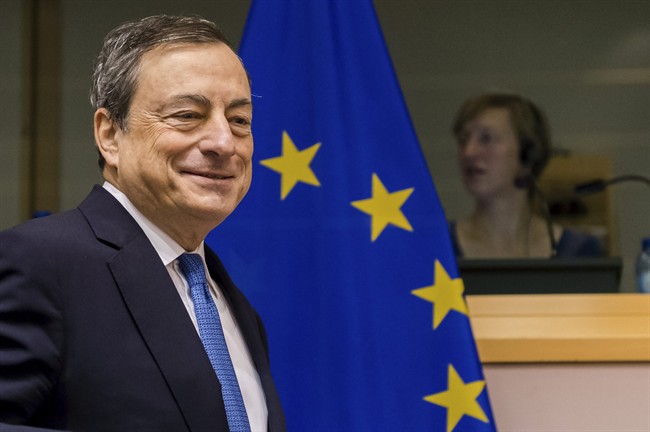FRANKFURT – How far will Mario Draghi and the European Central Bank go to boost inflation and a shaky economy?

Market participants are waiting for the bank rate decision and president’s news conference Thursday to find out.
Economists predict that the ECB’s 25-member governing council will follow through on Draghi’s comments in recent weeks that have been interpreted as a near-promise of more stimulus.
The question is, how much more? And how much good will it do?
Market analysts expect the ECB to cut the interest rate on overnight deposits left with it by commercial banks from minus 0.3 per cent to minus 0.4 or even minus 0.5 per cent. The negative rate is a drastic step aimed at forcing banks to lend cash rather than sit on it.
READ MORE: European Central Bank review shows hole in Greek banks’ finances smaller than first feared
The council could also increase the bank’s 60 billion euros ($66 billion) in monthly bond purchases by as much as 20 billion per month. The purchases are a way of pumping newly printed money into the economy. The bank could also extend the purchases, which are currently due to run at least through March 2017.
The ECB must juggle the desire for more stimulus with fears that the negative rate will ding bank profits, reducing their ability to lend.
One way to soften the impact on banks would be to use tiered negative rates, with banks paying less on lower amounts of deposits. It could also offer cheap long-term loans to banks.
With its stimulus, the ECB is trying to push up inflation from an annual rate of minus 0.2 per cent in February toward its goal of just under 2 per cent, a level considered healthier for the economy. Low or negative inflation is considered a sign of economic weakness and raises fears that low inflation expectations will become ingrained in wage and price agreements. That could hurt growth in the longer term.
Analysts are wondering to what extent the meeting will be a replay of the Dec. 3 meeting. The ECB increased its stimulus at that meeting, but it fell short of what market participants had expected and stock markets dropped sharply.
Draghi faces skepticism about the value of additional stimulus from some members of the governing council. One chief result of the negative interest rate and bond purchases has been a lower euro, which has fallen from around $1.40 in May 2014 to around $1.10 currently. The euro has risen, however, since the last additional dose of stimulus in December, suggesting additional rounds of monetary stimulus are having less effect in weakening the currency. The ECB says it does not target the exchange rate, but the lower euro has helped the economy by helping exporters.
The euro’s moves, against the dollar at least, seem as much determined by the U.S. Federal Reserve, which has started raising interest rates, which can boost the dollar.
The eurozone economy grew by a modest 0.3 per cent in the fourth quarter from the quarter before, while unemployment is high at 10.3 per cent and falling gradually. Domestic demand remains solid, but the eurozone could face trouble from a slowdown in China and emerging markets that could drag on exports, and from financial market turmoil that could scare businesses off new investment.
The Bank for International Settlements, an international organization of central banks, has said that central bank policies around the globe may be reaching the limits of what they can do after years of extraordinary stimulus, including low interest and money injections into the economy.



Comments